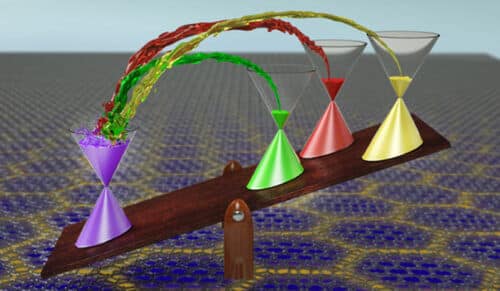Weizmann Institute of Science scientists managed to discover new transitions in the graphene system at the "magic angle"

It all depends on the weight, or, as physicists say, the effective mass. For example, when electrons move in a "normal" system, they are light and then their behavior is relatively simple. But when they move in a system made up of two graphene "plates", tilted relative to each other at an angle known as the "magic angle" - the electrons become "heavy" (that is, their effective mass increases) - and then strange phenomena occur. And as is known in the language of scientists, "strange" is interesting.
Prof. Shachel Ilani from the Department of Condensed Matter Physics at the Weizmann Institute of Science and the members of the research group he heads recently performed several experiments on a system of graphene surfaces at the "magic angle", and obtained some insights into the properties of "heavy" electrons moving in such a system. These discoveries are described in an article published in the scientific journal Nature.
Graphene is a two-dimensional lattice of carbon atoms, which conducts electricity and is free of impurities. These properties allow excellent mobility of electrons and minimal loss of energy. The developers of graphene, Prof. Andrey Geim from the University of Manchester and Prof. Konstantin Novoslov, won the Nobel Prize in Physics for this discovery in 2010. A few years after the discovery of graphene, other scientists - including a graduate of the institute, Dr. Rafi Bistritzer - proposed a theoretical prediction, according to which In a system built with two graphene surfaces placed at a certain angle to each other ("the magic angle"), the effective mass of the electrons will increase dramatically, which may manifest in the formation of phenomena such as magnetism, superconductivity, and more. This research earned Dr. Bistritzer and his research partners the 2020 Wolf Prize.
In 2018, scientists from the Massachusetts Institute of Technology, MIT, including Pablo Herrero-Herrero, succeeded in actually building the system of graphene surfaces at the "magic angle", and indeed managed to discover in it a property of superconductivity (the ability to transmit an electric current without resistance at all) . This work brought to the surface again the puzzle of the formation of superconductors at (relatively) high temperatures.
At this point, more or less, Prof. Ilani and the research students Uri Zondiner and Assaf Rosen at the institute, in cooperation with Hariro-Harero's group, decided to examine what was happening in this system. The electrons in the system are divided, according to their properties, into four "camps". In a normal situation the distribution is, more or less, random and equal. That is, in each of the four "camps" there is about a quarter of the number of electrons in the system. But at this point the scientists started adding electrons ("carriers"). Initially, the additional electrons were also divided more or less equally between the four "camps", but after the addition passed a certain "limit", all the electrons in the system (both existing and added) began to "flow" towards one particular "camp". When this "camp" was filled to the brim - the other camps were completely emptied of electrons and were "forced" to start filling up from the beginning. This Sisyphean process, where electrons fill a camp, are taken to another camp and start all over, is very different from the behaviors known in normal systems. The experimental results were explained by a simple theoretical model, formulated by professors Erez Berg, Adi Stern, Yuval Org and the post-doctoral researcher Dr. Rachel Koiros from the institute and Prof. Felix von Oppen from Frei University in Berlin. These discoveries are an important step on the way to understanding the special behaviors that the "Magic Angle" system showed. They can explain how this material becomes magnetic in a phase transition as well as the process by which the material becomes a superconductor. "At the end of this process", the scientists report, "the electrons from two different groups form 'pairs' (one from each group) and 'go out in a kind of dance'".
Knowing these phenomena and understanding them may help scientists to solve some of the big open questions in the physics of condensed matter, as well as promote the development of electronic systems of a new type, with new properties that cannot be obtained in any of the systems that exist today.
